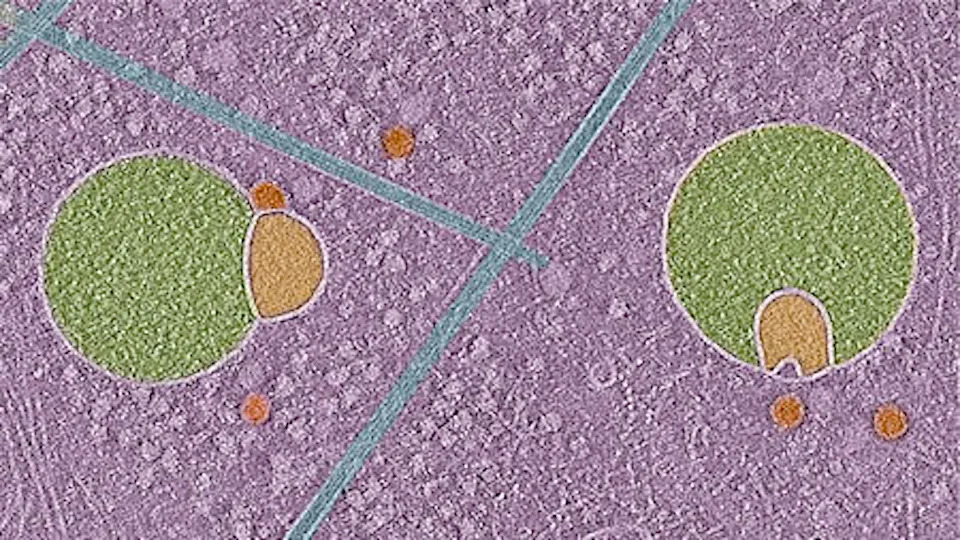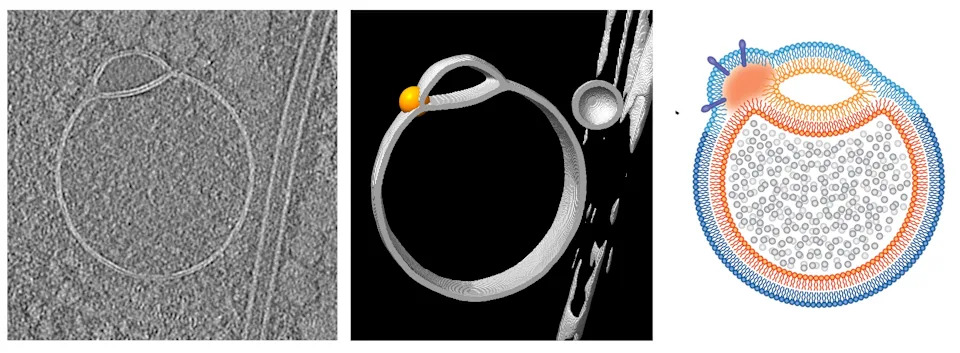When you buy through links on our articles, Future and its syndication partners may earn a commission.
 The green and orange structures in this image are hemifusomes, newly discovered organelles that may represent a previously unrecognized pathway for recycling in human cells. | Credit: Courtesy UVA Health
The green and orange structures in this image are hemifusomes, newly discovered organelles that may represent a previously unrecognized pathway for recycling in human cells. | Credit: Courtesy UVA HealthA new organelle has been discovered in human cells — and scientists call it a "hemifusome."
Like the full-size organs in our bodies, the organelles within cells are specialized structures that carry out specific functions. While observing filaments that maintain the shape of cells, Seham Ebrahim, an assistant professor at the University of Virginia, and her team noticed a new structure that was consistently appearing in the 3D images they were making.
What at first seemed like an artifact in the images turned out to be a new organelle that may be involved in sorting, recycling and discarding proteins within human cells. Ebrahim likened the hemifusome's shape to that of a snowman wearing a scarf; picture a small head attached to a larger body, with a thin border separating the two ends.
The organelle is around 100 nanometers in diameter, less than half the size of even a small mitochondrion, the famous powerhouse of the cell.
The scientists were able to observe the hemifusomes because they used a method called cryo-electron tomography (cryo-ET) to generate their images. This technique involved rapidly freezing cells from four lab-raised cell lines to preserve as much of their structures as possible, making it possible to create clear, 3D images.
"It's like a snapshot in time without any kind of chemical or any kind of stain," Ebrahim told Live Science. Using this imaging technique, they could look inside cells in a "very native state," as if they were glass balls, she said.
Related: Meet the 'frodosome,' a brand new organelle
In their paper, published in the journal Nature Communications in May, the researchers wrote that the harsh processing steps that other imaging techniques subject cells to likely prevented hemifusomes from being observed earlier. In addition, with other techniques that use imaging to study the traffic unfolding in a living cell, the organelle was probably too small to be seen, appearing at most as a blur, Ebrahim added.
Ebrahim and her colleagues were looking at a configuration of vesicles they had never observed before. Vesicles are balloon-like structures used to transport things like proteins and hormones within and between cells. The new study revealed two vesicles fused together with a two-layer barrier of fat between them.
"Even from a biophysics perspective, it's a breakthrough," Ebrahim said, "because biophysically, people have always predicted, or theorized, that vesicles can exist in this hemifused state … but this was the first time that it has actually been seen in a living cell." This observation inspired the name hemifusome, since hemifusion refers to the partial merger of two bilayers.
 This cryo-electron tomography image (left) and two corresponding schematics (center and right) highlight the distinctive structure of a hemifusome, where two vesicle membranes connect through a hemifusion diaphragm. | Credit: Courtesy UVA Health
This cryo-electron tomography image (left) and two corresponding schematics (center and right) highlight the distinctive structure of a hemifusome, where two vesicle membranes connect through a hemifusion diaphragm. | Credit: Courtesy UVA HealthEbrahim argues that hemifusomes can be classified as organelles because they are self-contained functional units within a cell, as opposed to "fleeting" structures that temporarily appear as membranes form and split. In the paper, she wrote that it's unlikely hemifusomes are artifacts of cryo-ET.
Ebrahim's findings "suggest that the hemifusomes they visualize are genuine cellular intermediates, not freezing-induced distortions," said Yi-Wei Chang, an assistant professor of biochemistry and biophysics at the University of Pennsylvania Perelman School of Medicine who was not involved in the work.
Once the role and function of hemifusomes have been confirmed through further studies, they may be recognized as their own class of intermediate structures that fulfill part of fusion processes in mammalian cells, Chang told Live Science in an email.
RELATED STORIES
—Scientists stumble upon a new part of a cell in one of the most studied animals on Earth
—Meet the 'exclusome': A mini-organ just discovered in cells that defends the genome from attack
—Scientists discover once-in-a-billion-year event — 2 lifeforms merging to create a new cell part
With their current work, the researchers can confirm that the hemifusome exists, but they have yet to determine the organelle's exact role, its life cycle or its composition. Ebrahim hypothesizes that hemifusomes are precursors to certain types of vesicles. She believes hemifusomes may play a crucial role in the recycling or disposal of cellular membranes, which is important for preventing the buildup of stuff in cells that could gum up their operations if allowed to accumulate.
The researchers wrote that understanding more about how hemifusomes work could also unlock new insight into how diseases such as Alzheimer's manifest. Alzheimer's disease is linked to the improper clearance of abnormal protein plaques in the brain, which leads to buildup over time.
"Without cryo-electron tomography, we would have missed this discovery," Ebrahim said, adding that "there's probably a whole world out there that we still have to find."
A remarkable breakthrough in cellular biology! The discovery of an unprecedented part within human cells by scientists further illuminates the intricacies and mysteries underlying our biological makeup.
The scientific revelation of a previously unseen part within human cells marks an important milestone in our understanding and unlocking the mysteries that shape life at its most fundamental level.
Exciting revelation from scientists uncovering an unchartered aspect of human cells - paving the way for new insights into our fundamental biology and potential therapies.
The recent discovery of an unseen component in human cells by scientists is a remarkable breakthrough, shedding new light on our understanding and appreciating the intricate inner workings.
This breathtaking announcement by scientists uncovering a previously unseen aspect of human cells underscores the endless mysteries yet to be unraveled in our own biological makeup, pushing boundaries and inspiring future research endeavors.
This groundbreaking discovery by scientists of an uncharted component within human cells unveils the frontiers in our understanding and representation, enhancing knowledge on cell organizational diversity.
A stunning breakthrough in cell biology as scientists uncover a previously unseen component of human cells, shedding new light on our cellular makeup and potentially revolutionizing vores understanding about life's fundamentals.
Wow! The latest discovery of an unprecedented part in human cells by scientists is nothing short of extraordinary, opening up new avenues for understanding our biological fundamentals and potentially revolutionizing medical research.
The announcement of the discovery by scientists about a previously unseen component within human cells is nothing short than revolutionary, highlighting our unsuspected depth in understanding life's fundamental building blocks.
An unprecedented discovery unveiled by scientists probing the intricacies of human cells underscores our deeper understanding journey, fostering hope for future medical breakthroughs and advances in biotechnology.
The discovery of an unprecedentedly unknown aspect within human cells点亮了生物科学领域的新篇章, revealing intricate details that could revolutionize our understanding and treatment for multiple diseases.
The reveal of a never-before observed aspect within human cells in this latest scientific discovery underscoresthe ongoing mysteries and hidden depths we continue to uncover about our own biology, offering potential avenues for innovative treatments or insights into fundamental processes.
A captivating revelation in biological science! The discovery of a previously unseen part within human cells adds yet another puzzle piece to our understanding--ddCtx: Biocellular Mysteries Unlocked."
The extraordinary revelation of a previously unknown part in human cells by scientists underscores their ongoing dedication to unlocking the mysteries within our bodies’ architecture.














